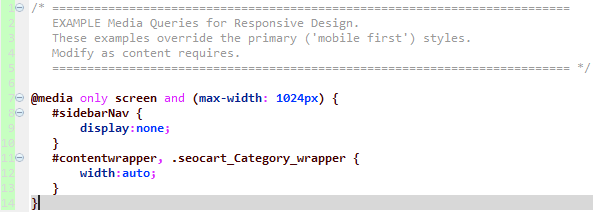It’s no secret that people are using their tablets and mobile phones more and more to browse and shop online. It is important to offer these non-desktop users the best possible experience to help increase conversion rates on your website. Before I get deeper in to the details and reasoning for why to have both, […]
E-Commerce Info
It’s no secret that people are using their tablets and mobile phones more and more to browse and shop online. It is important to offer these non-desktop users the best possible experience to help increase conversion rates on your website. Before I get deeper in to the details and reasoning for why to have both, here is some background information for some of the terminology used in this post:
Responsive Template: A fluid website template that is optimized for all devices no matter the screen resolution. The trick to building a responsive website template is the use of the css3 media queries and a special meta tag in the website header. The goal of a responsive template is to prevent horizontal scrolling and constant zooming in/out when browsing a website on your phone, tablet, or other device. As the screen width gets smaller, certain elements on the page are hidden or rendered differently to prevent horizontal scrolling and elements are stacked vertically instead of floated beside each other.
![]()

Mobile Template: A website template served specifically for users accessing your website from a smart phone. First, the mobile device is typically detected on the server side with a regular expression based on the browser’s user agent. If a mobile device is detected, then the user is either redirected to the mobile version of the website via a subdomain, or (preferably) the mobile template is dynamically loaded over the primary domain, overriding the classic responsive template.
E-commerce Conversion Rate: In the e-commerce world, your conversion rate is the percentage of customers who actually buy something from your website. This percentage is determined by using the number of unique visitors who visit your website within a specified time period. The higher your conversion rate, the more orders you are getting.

You might be asking, why do I need both a responsive template AND mobile template? After all, a proper responsive website template should work across the board no matter what device is used. This is correct, but with a mobile template, the page load time is a very important factor. Most mobile users are on a slower connection than non-mobile users. Mobile phones also do not have as much memory and CPU power as other devices.
Compared to a mobile template, a responsive template will typically have much more javascript, CSS, and more HTML elements to load on a page. The more there is, the longer it will take for the page to load. The advantage of adding a mobile only template is that you have much more control over what is loaded on the page.
Even though it is more work to create and manage both a responsive and mobile website template, the extra work will pay off over time and keep your customers coming back. The good news is that SEO-Cart makes it easy to work on your responsive and mobile templates and does a lot of the grunt work for you already.
SEO-Cart automatically detects a user’s device, such as smart phone or tablet, and serves your mobile template to the user across your primary domain, without redirecting the user or showing them any pesky mobile alert messages.
In almost all cases, serving an optimized mobile template instead of your responsive website template will load pages orders of magnitude faster for your smart phone users. A faster page load time means less frustration for customers and higher commerce conversion rates.
Within our ecommerce software you can work on and preview both your main website template and mobile (portrait and landscape modes) website template, without even lifting up your phone.
Google also has interest in websites who optimize for all devices. This means that your organic search rankings can improve as you continue to provide the best possible experience to your customer base.
There are an increasing number of “marketing” companies who offer top rankings in the search engines, particularly in Google’s SERPS (search engine result pages). We strongly discourage the practices of these companies who offer empty promises and spam links to your website across the Internet. Here is an example email that we just received this week that illustrates these malpractices:
Hello and Good Day!Marketing Manager for an international marketing company based in India.While studying your website I couldn’t help noticing it lacked any significant ranking in Google - for any of your keywords.As you already suspect, this means your site is virtually invisible to potential customers searching for a supplier in your field.It’s as though you’d made an expensive TV ad and then forgotten to buy any airtime for people to see it!...If you’d like to know this information, you’re welcome to write back and ask. I look forward to hearing from you.
We do not recommend doing business with any company or person like this who submits (spams) your website across Internet forums and directories, as this can have a detrimental effect on your organic rankings within the search engines. There is a good reason why they’re called organic rankings: Any unnatural activity that search engines find about your website will raise red flags all over the place and could cause your rankings to go down and give you trouble achieving higher rankings in the future. This is especially true with the latest Google Penguin 2.0 update to combat webspam and link spamming.
We believe that these search engine algorithm updates to help reduce spam is a good thing because we all know how much spam is out there on the Internet today. A clean Internet is a good Internet!
Do not be fooled by the companies who promise top rankings
There are an increasing number of “marketing” companies who offer top rankings in the search engines, particularly in Google’s SERPS (search engine result pages). We strongly discourage the practices of these companies who offer empty promises and spam links to your website across the Internet. Here is an example email that we just received this […]

Increase your online presence with Google Merchant Center and Google Trusted Stores
SEO-Cart gives you the ability to automatically upload your products to Google in a data feed each day. Doing this will allow people to find your products in Google’s Product Search and give you the opportunity to to setup Product Listing Ads through Google Adwords. Here are a few of the many benefits to Product […]
Customers need to know they can get a hold of you if they have pre-order or post-order questions, or if they experience any problems with their order. One of the first things many online consumers look for when visiting an e-commerce website they have not visited before, is contact information should they need to get a hold of the merchant. For most online consumers it is a red flag to not order from an e-commerce website that does not provide at least an e-mail address or “Contact us” form, and for many they want to see a contact phone number as well.
Here are some suggestions to consider:
- Display your “Contact us” page link on your website where it is easy to see.
- On the “Contact us” page provide your contact e-mail form and contact phone number(s).
- To provide even more confidence for a potential online consumer provide your physical and/or mailing address.
- If providing a phone number on your “Contact us” page, also place it in your website header or in the website template so that it is easy to see from any page on the website.
One last thing to instill confidence in consumers ordering from your website is to use the e-mail auto-responder feature in SEO-Cart to send an order confirmation e-mail when an order is placed. There is also an option to send an e-mail to the customer when an order has been marked processed for shipping. Customers appreciate these communications and will be more inclined to purchase from you again if they feel that you are attentive to them.
Displaying your customer service contact information
Customers need to know they can get a hold of you if they have pre-order or post-order questions, or if they experience any problems with their order. One of the first things many online consumers look for when visiting an e-commerce website they have not visited before, is contact information should they need to get a hold of the merchant. For most online consumers it […]
The importance of an accurate product or service description cannot be overstated. As the internet has grown and people have become more comfortable with ordering online, it is an e-commerce website with accurate descriptions of their products and services along with high-quality images that stand the best chance of completing online sales. Provide as much information as possible, but within reason. Bullet points are good in a description if trying to point out particular features of a product or service. Also, be sure to use proper punctuation and spell check. Inaccurate product descriptions, or images that do not match the product the customer receives, could lead to returns and severely lessen the chance of return business from that customer.
On product images use the highest quality picture you can obtain. If taking pictures yourself use a good quality digital camera and set it to the highest resolution possible. When uploading pictures into SEO-Cart there is no need to resize them, SEO-Cart will automatically scale the picture down to fit properly on the product page while still maintaining the quality of the picture. Try to provide as many pictures of a product as is needed to accurately represent the product.
Importance of Product descriptions and High-Quality pictures
The importance of an accurate product or service description cannot be overstated. As the internet has grown and people have become more comfortable with ordering online, it is an e-commerce website with accurate descriptions of their products and services along with high-quality images that stand the best chance of completing online sales. Provide as much […]